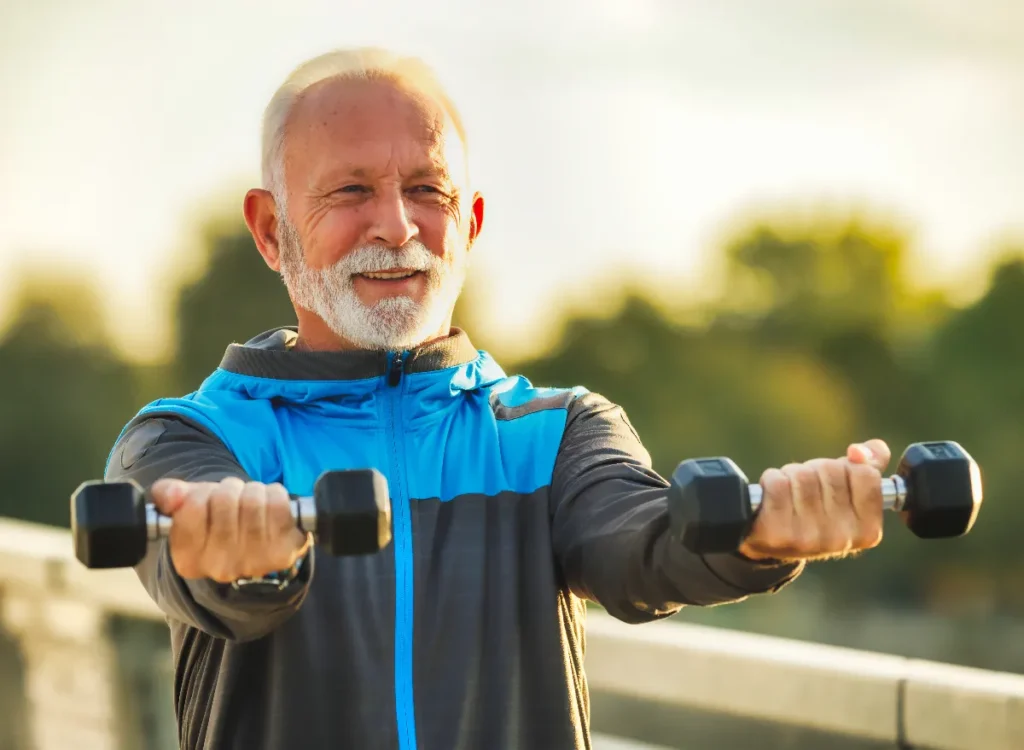Staying Fit and Strong as You Age After 60 is an Easy Task With Planed Steps
Aging is a natural process, but staying fit and healthy can help you maintain an active lifestyle even after 60. Regular exercise keeps your body strong, improves mobility, and enhances overall well-being. However, workouts after 60 should be safe, low-impact, and focused on flexibility, strength, and endurance.
Many seniors worry about injuries or think exercise is too strenuous for them, but the key is to choose exercises that match your abilities and needs. The right workout routine can boost your energy levels, reduce pain, and help you stay independent for longer. Let’s explore the best exercises for seniors, their benefits, and tips to stay injury-free.
Benefits of Exercise After 60

1. Improves Heart Health
Regular exercise strengthens the heart, lowers blood pressure, and improves circulation, reducing the risk of heart disease and strokes. Simple activities like walking or cycling can have a significant impact.
2. Enhances Muscle Strength
As we age, muscle loss is common, leading to weakness and reduced mobility. Strength training, even with light weights or bodyweight exercises, helps maintain muscle mass and keeps you active.
3. Boosts Bone Density
Weight-bearing exercises such as walking and strength training keep bones strong, reducing the risk of osteoporosis and fractures.
4. Increases Flexibility and Mobility
Stretching and movement-based exercises help prevent stiffness, making daily activities easier and reducing the risk of falls and injuries.
5. Supports Mental Health
Exercise releases endorphins, the body’s natural mood boosters. It can also improve sleep quality and reduce stress, anxiety, and depression.
6. Manages Weight
Maintaining a healthy weight is crucial for overall health. Regular physical activity helps control weight, reducing the risk of diabetes and other lifestyle diseases.
7. Enhances Longevity
Studies show that active seniors tend to live longer and enjoy a better quality of life. Exercise keeps the body and mind engaged, leading to a healthier, happier life.
Best Workouts for Seniors
Your workout routine should include a mix of cardiovascular, strength, flexibility, and balance exercises. Here’s a breakdown of the best options:
Cardiovascular Exercises

These exercises improve heart health, endurance, and stamina. Low-impact activities are best for seniors:
- Walking: A simple and effective way to stay active. Aim for 30 minutes daily.
- Swimming: Gentle on joints and great for full-body fitness.
- Cycling: Whether on a stationary bike or outdoors, cycling strengthens the legs and improves cardiovascular health.
- Dancing: A fun way to stay fit while improving coordination and balance.
Strength Training

Strength training helps maintain muscle mass and prevents weakness. Focus on exercises that build core and limb strength:
| Exercise Type | Exercises |
|---|---|
| Bodyweight Exercises | Squats (using a chair for support), Wall push-ups, Seated leg lifts |
| Resistance Band Workouts | Bicep curls, Shoulder presses, Seated rows |
| Light Dumbbell Exercises | Overhead press, Arm raises, Side bends |
Special Note: Seniors should start with light weights or resistance bands and focus on proper form. Avoid overexertion, and rest adequately between sets. If you have joint pain or limited mobility, consult a trainer or physical therapist for modifications.
Flexibility and Stretching

Stretching prevents stiffness and improves mobility. Simple stretches to incorporate daily:
- Neck Stretch: Slowly move your head side to side.
- Shoulder Rolls: Roll shoulders forward and backward.
- Seated Hamstring Stretch: Extend one leg forward and reach toward your toes.
- Cat-Cow Stretch: Improves spinal flexibility and relieves back pain.
- Standing Quadriceps Stretch: Hold your ankle behind you to stretch your thigh muscles.
Balance and Stability Exercises

These exercises help prevent falls and improve posture. Balance is crucial for maintaining independence:
- Heel-to-Toe Walk: Walk in a straight line, placing one foot directly in front of the other.
- Single-Leg Stand: Hold onto a chair for support and balance on one foot.
- Tai Chi or Yoga: Both practices improve coordination, balance, and relaxation.
- Side Leg Raises: Strengthens the hips and enhances stability.
Special Note: If you have a history of falls or balance issues, perform these exercises near a stable surface, like a wall or sturdy chair, for support.
Tips for Safe Workouts
Staying safe while exercising is essential. Follow these tips to prevent injuries and maximize benefits:
- Warm-up and Cool-down: Always start with gentle stretching and end with slow movements to relax muscles.
- Listen to Your Body: If you feel pain or discomfort, stop and rest.
- Stay Hydrated: Drink enough water before and after workouts to prevent dehydration.
- Use Proper Footwear: Wear comfortable, supportive shoes to avoid slips and falls.
- Modify Exercises: Adjust workouts to your comfort level and ability.
- Stay Consistent: Aim for at least 150 minutes of moderate exercise per week.
- Consult a Doctor: If you have medical conditions, talk to your doctor before starting a workout plan.
Sample Weekly Workout Plan
| Day | Activity |
|---|---|
| Monday | 30-minute walk, 10-minute stretching |
| Tuesday | Strength training: Bodyweight squats (2 sets of 10), Wall push-ups (2 sets of 10), Bicep curls with light dumbbells (2 sets of 10) |
| Wednesday | Balance & Mobility: Tai Chi or Yoga (20-30 minutes), Heel-to-toe walk (2 sets of 10 steps), Single-leg stand (10 seconds per leg) |
| Thursday | Cardio & Strength: 20-minute cycling or swimming, Shoulder presses (2 sets of 10), Side leg raises (2 sets of 10) |
| Friday | Flexibility & Relaxation: Gentle stretching routine (15 minutes), Deep breathing exercises |
| Saturday | Cardio & Fun Activity: Dance, brisk walking, or gardening (30 minutes) |
| Sunday | Rest & Recovery: Light stretching or meditation |
Special Note: Adjust the workout intensity based on your fitness level. If you experience joint pain or fatigue, reduce the number of repetitions or take additional rest days as needed.
Staying active after 60 is one of the best ways to maintain good health, energy, and independence. The key is to find enjoyable exercises that suit your fitness level and daily routine. Whether it’s a morning walk, a yoga class, or lifting light weights, every movement counts toward a healthier life.
Exercise doesn’t have to be intense to be effective—consistency is what matters most. The more active you are, the better you’ll feel, both physically and mentally. Keep moving, stay consistent, and embrace a fit and strong life after 60!

